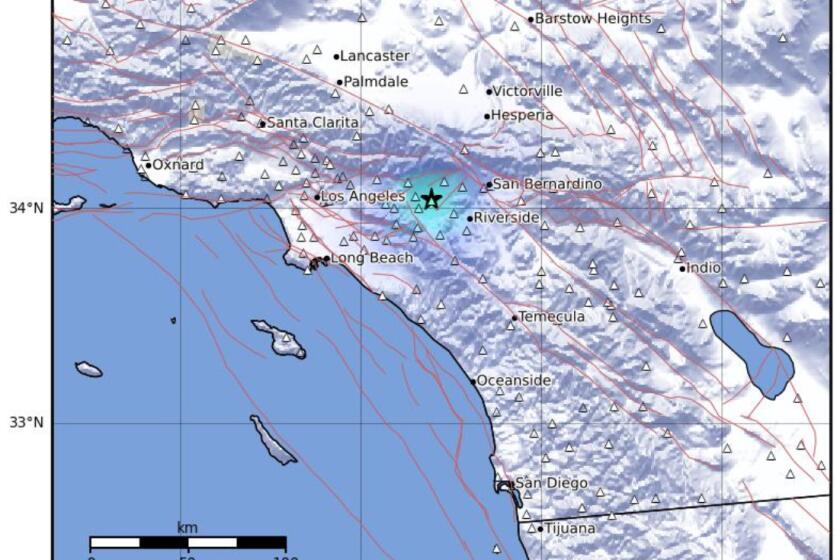A Painful Return for Quake Victims : Recovery: Ex-residents of a damaged Santa Monica building are allowed back to retrieve belongings for the first time since the temblor. Damage and vandalism overwhelm some of them.
For Shane Walker, it was a chance to retrieve some of his fashion sketches, a piano and a surfboard. Beverly Voran wanted some shelving and a last ocean view from her fifth-floor window. Victor Alferos got his framed pictures and a still-intact bottle of scotch.
They were part of a parade of former residents of the earthquake-damaged Sea Castle apartments in Santa Monica making an emotional pilgrimage to the building Monday, given their first opportunity to remove their belongings since the landmark structure was sealed off after January’s temblor. As they stumbled down musty stairwells clutching their possessions, many were overwhelmed by the damage done not only by the quake, but also by those who have had full run of their rental units for the past eight months--insects, rodents and burglars.
They also confronted the possibility that their visit to the severely damaged building--once the jewel of the Santa Monica waterfront and now subject to bank foreclosure proceedings--may be their last.
“We’re not just losing a home, we’re losing a whole community--everyone was so close here,” said Voran, a decade-long resident. “I just cry about losing this view. That’s why I lived in this unit, which is the size of a closet, for so long.”
The Santa Monica Fire Department has notified the building’s former residents, many of whom are now scattered throughout Southern California, that each will have four hours to pick up the pieces of their previous lives. On Monday, police and fire officials were in attendance as the recovery work began--and so was the Red Cross, available for psychological counseling.
A list of “Helpful Hints for Possession Recovery,” sent out by the Fire Department, offered suggestions such as, “Come with a positive attitude--it is not a pretty sight,” and, “Bring dust masks, rubber gloves and insect repellent.” Warnings were given about dirt, mold and mildew, and flashlights were recommended.
The Fire Department’s suggestions scared a few residents, not to mention the hired help. Chris’s Moving Men, a Culver City moving company, barred its workers from the premises after reading the “helpful hints.”
“You think of our workers in dark hallways and stairways--they’ll be panting pretty good and we’re worried about the health hazard,” said Carol Wood, one of the firm’s managers. “Who knows what bacteria is growing or what kind of creature is lurking in there.”
But Los Angeles County health officials who inspected the building Monday deemed it suitable for temporary entry. The hallways were well guarded and brightly lighted, and the most dangerous areas sealed off. A light sea breeze blew through numerous open windows and some holes in the walls.
Still, some hallways were strewn with the feathers of pigeons that had gotten caught there and were eaten by rats. A few units with leaky fire sprinklers were covered with mold, earning the sobriquet “mushroom factories” from fire officials. And when a county health worker opened one refrigerator, hundreds of gnats were swarming inside.
Vandals did their heaviest damage to the upper floors. Many doors had been smashed in and personal property ransacked. Computers lay upside down, guitars stripped and broken. One unit had been inhabited for weeks by a squatter and a dog.
“The earthquake was bad enough, but to then be violated again like this is horrible,” said Barbara Held, a Santa Monica fire inspector.
It is a sad state of affairs for what once was the centerpiece of Santa Monica’s beach vacation community. The large lime-green structure, a candidate for the National Register of Historic Places, was built in 1926 as the Breakers Beach Club and re-christened the Grand Hotel in 1934 at a lavish event attended by Jean Harlow, Joan Crawford, Ida Lupino and Maureen O’Sullivan.
During World War II, the structure became housing for noncommissioned military officers. After the war, the building was part of the Chase and Monica Hotels chain. In the early 1960s, it was converted to apartment units.
*
In recent years, tenants have been embroiled in numerous disputes with landlord Robert Braun, clashing over rent increases, the building’s lack--until recently--of a sprinkler system and the structure’s general state of disrepair.
After the earthquake, the city of Santa Monica, backed with an order from its nuisance abatement board, was unable to get Braun to shore up the building. The city itself has spent $180,000 to strengthen the structure and is seeking reimbursement, putting a lien on the property.
The Santa Monica Rent Control Board will consider Thursday whether to exempt Braun’s building from rent control. The board could vote to issue a permit under the city’s post-earthquake recovery program, allowing reconstruction costs to be recouped by market-rate rents. But at a conservative renovation estimate of $7.5 million, rent control officials say it is doubtful even market rents would cover the cost.
Braun’s attorney, Sherman Stacey, declined to say what Braun’s plans were, but noted that if the exemption passes, “he can do whatever he wants to do.”
Meanwhile, Braun faces a bigger hurdle. An official at First Federal Bank of California says foreclosure proceedings have commenced against the Sea Castle apartments for a defaulted mortgage loan.
*
That leaves many residents to wait out what could be a few years of litigation. Some have decided to throw in their beach towels.
“I’m just kind of numb,” said Alferos as he moved his belongings. “I just want to get this done and get out of here.”
More to Read
Sign up for Essential California
The most important California stories and recommendations in your inbox every morning.
You may occasionally receive promotional content from the Los Angeles Times.










